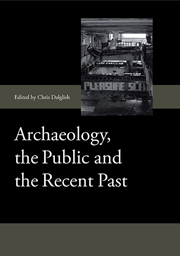Book contents
- Frontmatter
- Contents
- List of Figures and Tables
- List of Contributors
- Archaeologists, Power and the Recent Past
- Part One Constructing Memories, Constructing Communities
- Part Two Engaging the Past, Engaging the Present
- Politics, Publics and Professional Pragmatics: Re-Envisioning Archaeological Practice in Northern Ireland
- Archaeology, Politics and Politicians, or: Small p in a Big P World
- ‘No Certain Roof but the Coffin Lid’: Exploring the Commercial and Academic Need for a High Level Research Framework to Safeguard the Future of the Post-Medieval Burial Resource
- ‘Men That Are Gone … Come Like Shadows, So Depart’: Research Practice and Sampling Strategies for Enhancing Our Understanding of Post-Medieval Human Remains
- Dialogues Between Past, Present and Future: Reflections on Engaging the Recent Past
- Index
‘Men That Are Gone … Come Like Shadows, So Depart’: Research Practice and Sampling Strategies for Enhancing Our Understanding of Post-Medieval Human Remains
from Part Two - Engaging the Past, Engaging the Present
Published online by Cambridge University Press: 05 September 2013
- Frontmatter
- Contents
- List of Figures and Tables
- List of Contributors
- Archaeologists, Power and the Recent Past
- Part One Constructing Memories, Constructing Communities
- Part Two Engaging the Past, Engaging the Present
- Politics, Publics and Professional Pragmatics: Re-Envisioning Archaeological Practice in Northern Ireland
- Archaeology, Politics and Politicians, or: Small p in a Big P World
- ‘No Certain Roof but the Coffin Lid’: Exploring the Commercial and Academic Need for a High Level Research Framework to Safeguard the Future of the Post-Medieval Burial Resource
- ‘Men That Are Gone … Come Like Shadows, So Depart’: Research Practice and Sampling Strategies for Enhancing Our Understanding of Post-Medieval Human Remains
- Dialogues Between Past, Present and Future: Reflections on Engaging the Recent Past
- Index
Summary
The public generally accepts that human remains are often disturbed during the course of redevelopment and that, legally, such remains have to be removed. However, it is clear that the public and other stakeholders also tend to hold a variety of opinions with regard to the acceptance oj handling human remains and of studying, retaining and/or disposing of them after they have been removed. Where funding or time constraints linked to reburial do not permit detailed study, we suggest that there is a need to define acceptable policies for the sampling of human remains to ensure that the resource is sustained for future study. This concept is particularly important in major urban centres where piecemeal excavation of original burial grounds is commonplace, with different portions of the same cemetery often excavated decades apart. Post-medieval burial grounds and crypts can pose particular problems because of the increased potential there for the survival of well-preserved human remains and associated artefacts. These assemblages can offer a wealth of information, particularly where augmented by parish records and/or epigraphic data. This paper considers best practice for optimising the research potential whilst recognising that sampling is an emotive issue both amongst practitioners studying human remains and the wider public. It advocates a consortium approach which recognises the value of specialist input to the planning and excavation phases of a project.
- Type
- Chapter
- Information
- Archaeology, the Public and the Recent Past , pp. 145 - 162Publisher: Boydell & BrewerPrint publication year: 2013



